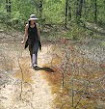I love the Hallowe'en front porch displays, especially the gourds. But at this time of year what I really want in my yard is a Shagbark Hickory Carya Obvata.
I don't have any good pics of mature Shagbarks myself, but here is a perfect one - do you see what I mean?
What an unapologetically feral looking tree. In an urban residential front yard, it would stick out like a defiant middle finger among (and towards) any manicured properties around it. I'd like to meet the person who would plant this as a high wildlife value specimen tree in their front yard.
And, yes, a perfect tree for Hallowe'en. As William Cullina wrote, the bark's sheets "...hang there forlornly, so the whole tree takes on a shaggy, uneven aspect ... the bare trees seem alive and almost sinister on a wet foggy day."
Intrigued? This article is worth a read: Shagbark Hickory (Carya ovata) Ontario Arborist, May/June 2010, Michael Richardson, B.Sc.F., Consulting Arborist. Couple of highlights:
Shagbark Hickory as bat habitat:
"The bats use the trees as roost and maternal sites and apparently not only use the peeling sheets to hide under but finds that shagbarks provide excellent thermal regulation. In Ontario, species such as the little brown bat (Myotis lucifugus), the silver-haired bat (Lasionycteris noctivagans), and likely the big brown bat (Eptesicus fuscus) are found using live shagbarks. It seems clear that in forests and urban situations, the loss of dead trees with sloughing bark has lead to a decline in bats using natural roost sites. Shagbark hickories provide excellent roost sites as the bark begins to shed at 10+ years and can continue to provide outstanding habitat for two centuries or more."Shagbark Hickory and First Nations arboriculture:
"First Nation people may have practiced arboriculture, and this, along with their agricultural practices, helps to explain the range and density of shagbark hickory. By managing individual trees and entire landscapes, these peoples have had a great influence on forests in eastern North America. First Nations were once considered to be in harmony with nature, but now many scientists believe that they were in fact a “keystone” factor in ecosystem development. [here's a wikipedia definition of 'keystone species']Here in Toronto, I know Steve Smith / Urban Forest Associates plants them in the Don Valley (a young grove of them in Windfields Park for one). I'm already excited to see them when they mature. I especially want to walk among their silhouettes some dusky October eve.
Throughout the world, traditional cultures farmed various fruit and mast trees, which made survival easier than that of the constantly moving hunters and gathers. This has been termed balanoculture. In eastern North America, shade-tolerant forests (maple-beech) could not meet the dietary requirements of First Nations. The manipulation of forests – and in fact entire landscapes – using deliberately set fires was a method to help assure sufficient food stuffs.
The use of fire, planting, tree girdling and forest thinning allowed creation of “orchards” of hickory and other mast crops. Hickory nuts were one of the main foodstuffs for many First Nations throughout eastern North America. Nuts and acorns are calorie packed and could be stored. The sweet nuts of shagbark hickory seemed to be particularly favoured and are amongst the highest caloric ratings of mast crops.
In eastern North America, the distribution of early succession forests and hickory, oak and chestnut appear to be strongly predicted by First Nation occupation. This relationship is so strong that estimates of occupation is a better predictor of oak, hickory and chestnut than a number of topographic and soil variables."

1 comment:
These are great quotes. I have noticed that these trees once seeded usually by squirrels will grow out into a field quite quickly from the forests edge. In three years I had over 100 growing stretching 30 m from the forest's edge. Typically thought of as a slow grower, some grew almost 2 feet per year with barely more than 2 feet of soil before the limestone bedrock. Not bad for a tap rooted tree!
Post a Comment